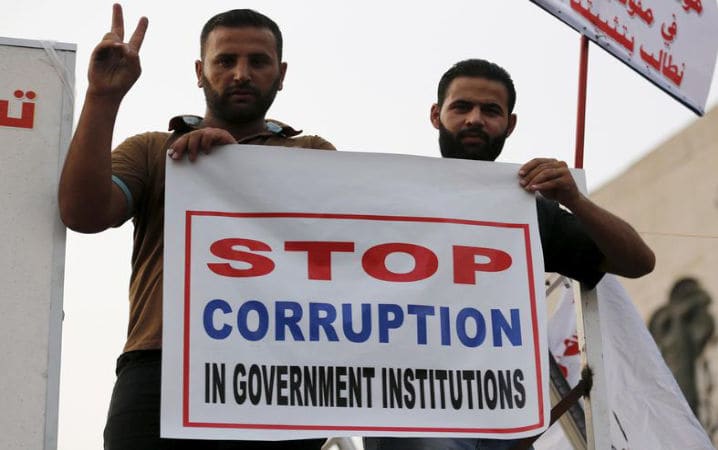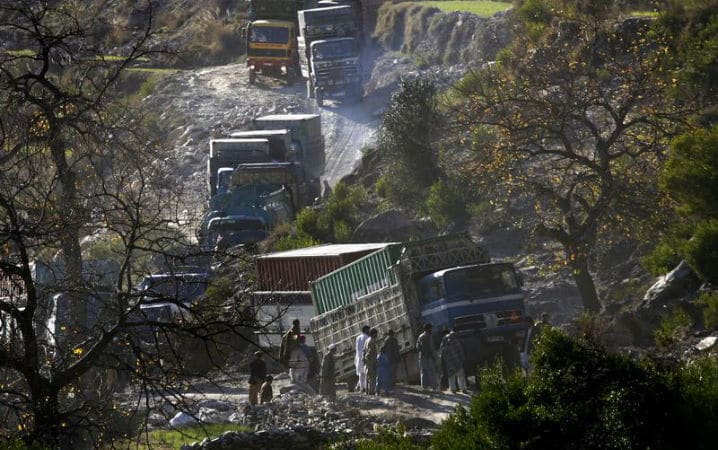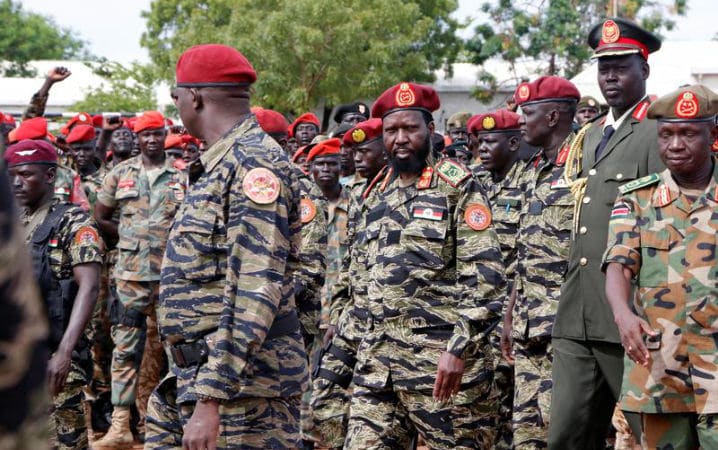Corruption has been a staple of development debates since the mid 1990s. Its corrosive effects are well documented: deep-rooted corruption prevents inclusive economic growth, diverts aid and subverts international development aid. But an equally important consequence of widespread corruption is far less recognised and far less studied: its impact on national and international security. This is why corruption matters to NATO.

Iraqi men demonstrate against corruption and poor services in Tahrir Square, central Baghdad, Iraq. An eight-month-long investigation by the Iraqi Parliamentary Committee for Security and Defense, released in August 2015, showed that financial and administrative corruption fed the rise ISIS/Daesh and local militias in Iraq. © Reuters
Corruption and state capture contributed to the outbreak of the Arab Spring and subsequent conflicts. It was a key factor in the defeat of Iraqi forces during the first battle of Mosul. It fed the rise of ISIS/Daesh and Boko Haram. And it has been used as a foreign policy tool by some states to actively undermine institutions in others.
Corruption was also a key factor contributing to the failings of international interventions in Iraq and Afghanistan. Widespread corruption and state capture by criminal networks undermined the legitimacy of the Afghan government, reduced its effectiveness and created a source of resentment for its own population. It has driven Taliban recruitment, which made it much more difficult for the NATO-led International Security Assistance Force (ISAF) (2003-2014) to achieve its key mission goals, from security to effective governance. In the words of Ryan Crocker, former United States Ambassador to Afghanistan: “The ultimate point of failure for our efforts…wasn’t an insurgency. It was the weight of endemic corruption.” (2016)
In Iraq, corruption in army recruitment and promotions, the existence of ghost soldiers, and theft of weapons and supplies rendered the army – superior on paper – ill-armed, under-manned, and ultimately unable to halt the rise of ISIS/Daesh. To stop the jihadi fighters, international troops had to return to Iraq a couple of years after the previous training mission was concluded.
And yet, the linkages between corruption and insecurity have not become an integral part of key security-related debates and plans. Even when corruption is acknowledged as a strategic challenge, this recognition is rarely translated into specific guidelines and tools that could protect international engagement from corruption risk. Perhaps even more importantly, such measures could help avoid situations in which international interventions inadvertently end up supporting corrupt networks and seeing their resources diverted.
These considerations are key for military operations ranging from defence capacity building to stabilisation, crisis-management and peace-support missions. Operations bring in significant amounts of resources, both tangible – from local sustainment to training and equipment – and intangible, such as support for the host nation’s government and armed forces. If planners and implementers are not careful, these resources can be diverted and misused by corrupt networks and spoilers profiting from chaos and instability.
NATO and anti-corruption
Until the 2016 Warsaw Summit, NATO was active in the anti-corruption realm chiefly through its Building Integrity (BI) programme, which focuses on the analysis of corruption risks in defence sectors and helps design national anti-corruption programmes. A step change occurred in Warsaw with the adoption of a BI policy, which goes beyond the initial scope of the programme. The policy makes clear that preventing and countering corruption needs to be incorporated into the Alliance’s key tasks: from collective defence to crisis response to cooperative security. A BI action plan aiming to integrate anti-corruption considerations into NATO’s activities followed shortly after.
The significance of the policy and the action plan is difficult to exaggerate. In Afghanistan, ISAF’s mission did not begin to address corruption issues until 2007. It took nine years – until 2012 – for mitigating the impact of corruption to become a line of engagement in the ISAF Operations Plan.
Neglecting corruption issues in planning and tasking made it more difficult to recognise their manifestations and consequences, in particular the impact corruption issues had on the mission’s ability to meet its objectives. It meant that the injection of resources that far exceeded Afghanistan’s absorptive capacity was not picked up on as a key risk. Local sustainment contracts – such as the Host Nation Trucking Contract which fed warlords and corrupt officials – were not analysed for their potential benefit to corrupt networks. In effect, ISAF exacerbated the corruption risks it later struggled against.

During the early years of its mission, the NATO-led International Security Assistance Force neglected the impact that local contracts, such as hiring local trucks to transport supplies, had on corruption. © Reuters
One reason for the slow response is that deployed forces were not used to dealing with the issue of corruption. It was only too easy to regard it as a development question that could wait until security had been established. Without guidance such as standard operating procedures and with little readily available expertise, an issue like corruption is difficult to address even if it is noticed, especially in an insecure environment – when bullets start flying, there is little time or capacity to think through and implement mitigations for an unfamiliar risk.
This is where the NATO BI policy can help. If seen as a standard-setter and implemented by NATO Allies, the policy can help ensure that corruption is taken into consideration in NATO and national planning for military operations. This in turn will increase the preparedness to face it in theatre, to identify high-risk environments, to put in place mitigation measures before troops are deployed, to monitor the impact of corruption on the mission, and to note mission activities which could exacerbate the severity and reach of corrupt practices. It should also help the Allies to build relationships with organisations that can assist them in theatre and to identify sources of technical expertise that are likely to be of help.
The importance of defence governance
While corruption in any sector can be damaging, corruption in the defence and security forces –those tasked to protect the population and respond to insecurity – is particularly pernicious. In some cases, the effects of corruption are immediately visible, with predatory security forces abusing the populations they were set up to protect. In other cases, the secrecy and confidentiality that often accompanies this sector can hide the effects of corruption, until a crisis and a large-scale failure.
When a military fails, it fails spectacularly: ineffective, hollowed-out forces create the space for the likes of Boko Haram, ISIS/Daesh and organised crime groups to thrive. The consequences are too big to be ignored by either the security or the development community: if peace and security are to take hold and create conditions for development, addressing defence and security corruption – especially in fragile and conflict-affected states – must be a priority for both.
A combination of secrecy, perceived security needs and national prestige often makes it difficult to reform defence and security institutions. Yet without reforming them, stability and security cannot take root.
In the early years after independence in South Sudan, for example, the ruling elite diverted oil revenues to fund patronage networks through defence sector expenditures. A bloated military budget was used to pay the salaries of 230,000 soldiers and militia members belonging to various patronage networks. Meanwhile, other departments’ budgets were raided and resources redirected to the defence sector: in 2012, when defence and security expenditure constituted 35 per cent of South Sudan’s budget, donors funded 75 per cent of South Sudan’s health sector.
For a few years, the patronage system worked in South Sudan; loyalty was bought and violence kept in check. But in 2012, increasing prices of loyalty, a spat with the Sudanese government over the use of oil infrastructure, and a global decline in oil prices led to decreasing production and lower revenues. This diminished the ability of President Salva Kiir’s government to buy the loyalty of its opponents, so Kiir resorted to dismissing his opponents. Within a year, civil war and a humanitarian crisis engulfed the country.
Robust defence governance is especially important when defence spending rises, or when countries otherwise expand their armed forces and the reach of their security and defence policy. Currently defence spending is rising the fastest in countries where defence governance standards are weakest. In 2016, 22 African states spent over five per cent of their budgets on defence, while seven countries spent over ten per cent. This is a significant investment, one that can divert resources from other public services, including health and education. But in many of the countries where spending is increasing, the development of effective oversight mechanisms is failing to keep pace. Defence budgets are mostly opaque and exempt from external scrutiny, and the arms and equipment acquired are rarely well planned nor do they contribute to the armed forces’ effectiveness.

South Sudan's President Salva Kiir (centre) diverted oil revenues to fund patronage networks through a bloated military budget, which payed the salaries of 230,000 soldiers and militia members. © Reuters
NATO is no newcomer to spreading high standards of defence governance: its acceptance of new member states has been conditional on their adherence to good governance of their defence forces, including democratic and civilian oversight. The Alliance, which remains an important source of norms and standards in defence, is well placed to help other countries improve their defence governance. The Alliance’s new training and capacity-building mission in Iraq, for example, must incorporate measures to fight corruption and strengthen the governance of Iraq’s defence sector. As the battle of Mosul and the rise of ISIS/Daesh suggest, limiting the impact of corruption needs to be a priority if the Iraqi forces are to be able to build on the gains made in the last couple of years.
Crisis management and stabilisation missions
In recognition that the Alliance was ill-prepared to mitigate corruption risks in operations, the BI policy requires good governance and anti-corruption concerns to be considered at all stages of operational planning and execution. This is a key challenge for Allies. Research by Transparency International (TI) has identified the ability to recognise and mitigate corruption risks as a weak link among NATO Allies and partners. In only three countries did we find evidence of doctrine addressing corruption, guidance on operational procurement, or anti-corruption training for troops.
NATO’s role as a standard setter could help increase national preparedness, both through providing good practice guidance and through exposing officers to the issue, as they rotate through the NATO systems. The Alliance’s Joint Warfare Centre, for example, has been incorporating corruption-related themes into the exercises they conduct (which TI – Defence and Security has participated in). Pulled by the Annual Guidance on Exercises of the Supreme Allied Commander Europe, which includes mitigating corruption among exercise outcomes, and pushed by the needs of NATO Force Structure Headquarters – many of which have recognised corruption as a challenge – exercises have been the most visible aspect of NATO’s attempts to mitigate corruption risks. The investment in exercises has already resulted in changes in standard operating procedures, and is likely to yield even greater returns if continued.
Exercises are particularly useful for realising that countering corruption is both a technical and a political issue. Without leadership pressure, technical solutions are unlikely to get traction. Without technical expertise among staff officers, top-level commitment cannot be realised, simply because nobody will know how to translate it into technical solutions. In environments where corruption is a significant risk, it makes sense to reinforce military staffs with experts from other institutions, from law enforcement to governance. However, each headquarters does need a baseline of expertise, if only to be able to recognise and define a threat when it appears, and know where to look for help.
Allied resilience
The impact of corruption on national security, sovereignty and independence has been well illustrated by the developments in Ukraine. Former US Vice President Joe Biden stated, in 2009, that “Russia over the last decade or so has used another foreign policy weapon. It uses corruption as a tool of coercion to keep Ukraine vulnerable and dependent. So pursue those reforms to root out corruption. It’s not just about good governance. It’s about self-preservation. It’s about your very national security.”
Corruption is frequently thought of as a cancer – a malicious but amorphous force undermining development and security. This interpretation, however, misses the crucial ways in which corrupt practices can be used intentionally, consciously employed by one state to undermine another’s choices and freedom of manoeuvre. Corruption vulnerabilities, especially in the key defence and energy sectors, should be viewed as enablers for unconventional warfare which threatens NATO Allies and partners.

The Mezhyhirya Residence – the estate where Viktor Yanukovych lived when he was Prime Minister and then President of Ukraine – is now a museum displaying Yanukovych's luxurious lifestyle. He fled to Russia following the 2014 Ukrainian revolution, which was brought on by massive protests against corruption. © Wikipedia
The threat that corruption can pose to national sovereignty and security should be incorporated into NATO’s response to hybrid threats, which currently appears to focus primarily on disinformation and cyberattacks. While these issues should not be neglected, a focus on maintaining resilient defence institutions that are well connected with their populations would be a desirable contribution to countering potential hybrid threats.
Way ahead
Thanks to the BI policy and its capacity-building work, NATO is currently at the forefront of security and defence establishments aiming to mitigate corruption risks. But it is important not to rest on one’s laurels; a lot still needs to be done. Progress on exercises does not appear to have been matched by development of strategic and operational guidance, or by updating key doctrines to guide planners.
NATO has also not made it easy for independent organisations, including civil society, to monitor and contribute to the implementation of the policy. The fact that the BI action plan has not been made public means there are limited opportunities for external organisations to contribute. While it is understandable that some aspects of the action plan and its implementation might need to remain classified, it is unlikely that this applies to the entirety of NATO’s plans and actions. Corruption in defence and security is a shared concern, one that would benefit from a coalition of committed actors around it, a coalition which could also benefit the Alliance in a crisis.
As NATO structures incorporate anti-corruption concerns into their procedures, the next challenge is to ensure that these norms and practices adopted throughout the Alliance are reflected in national defence establishments. The BI policy makes any actions by Allies voluntary, and yet maintaining high standards of defence governance is crucial: among other benefits, it will help ensure that planned increases in Allies’ defence budgets to two per cent of GDP will be well spent. Peer consultations and peer experience is one key way to maintain and improve institutional capacity.
Exercises could also become a vehicle for spreading anti-corruption norms and practices among Allies. For that, however, anti-corruption might need to become an element of NATO’s formal certification requirements. The Alliance would also need to develop a variety of anti-corruption scenarios and train evaluators who can identify challenges and advise on best practice.
The final challenge for NATO’s anti-corruption work is cooperation with other institutions, most notably the European Union. The European Commission’s Directorate General for Neighbourhood and Enlargement Negotiations (DG NEAR) currently sponsors NATO’s BI programme, recognising that defence governance is a key factor in sustainable security and stability. However, more could be done, including joint work on incorporating anti-corruption measures into standard operating procedures and operational planning processes for international deployments; cooperation on corruption vulnerabilities as part of hybrid warfare; and defence capacity building in partner countries. With both organisations facing similar challenges, it certainly makes sense to seek out synergies.
Publications issued by TI-Defence and Security (available here) offer more in-depth analysis of the links between corruption and insecurity (The Fifth Column), the links between corruption and violent extremism (The Big Spin), promoting accountability in the defence industry, and related issues. TI-Defence and Security has launched an initiative aiming to promote standards of responsible defence governance; in January 2019, it will publish a toolkit to help mitigate corruption risks in operations and defence capacity building.
